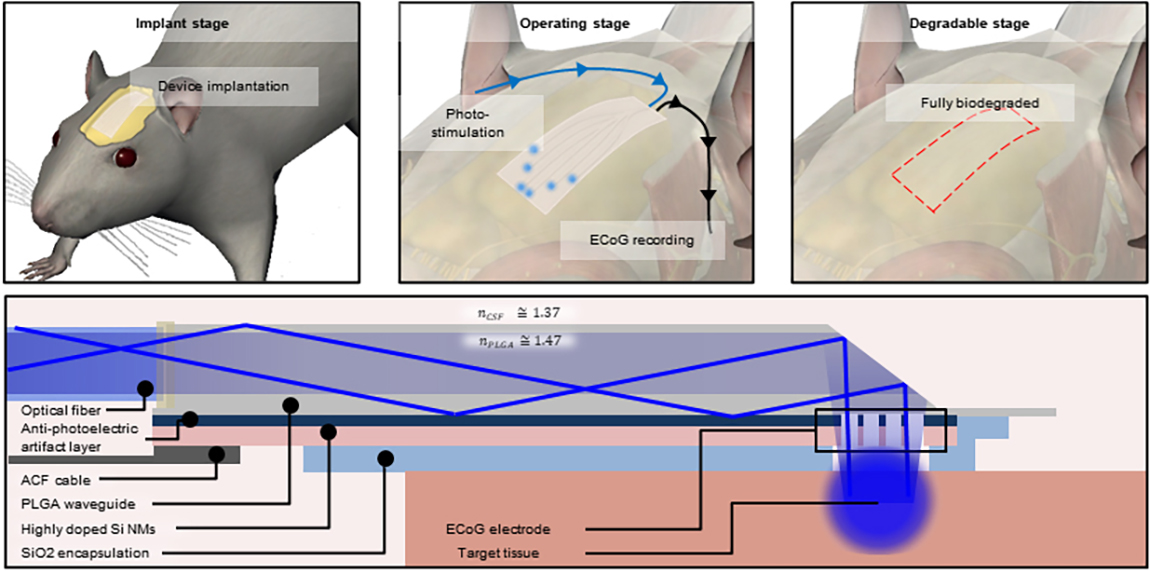The World's First Fully Biodegradable Multifunctional Neural Implant System Developed
The World's First Fully Biodegradable Multifunctional Neural Implant System Developed
Minimizing tissue damage and inflammatory responses with the hope of treating intractable brain diseases
Reducing healthcare costs with the biodegradable device by eliminating the need for a second surgery
Professor Yu Ki-Jun, from the Department of Electrical and Electronic Engineering, College of Engineering, has collaborated with Professor Cho Il-Joo from Korea University School of Medicine and Professor Lee Gil-Ju from the Pusan National University Department of Electrical and Electronic Engineering to develop the world's first multifunctional and fully biodegradable opto-electronic neural implant system, which has been considered a challenge in the fields of materials as well as electrical and electronic engineering.
The research team utilized this system to simultaneously perform photo-stimulation of the cerebral cortex and EEG monitoring in a rodent model in real time, while avoiding mutual interference. Furthermore, they successfully verified that the device used was completely degraded and absorbed in the body.
One of the characteristics of this technology is that the device works temporarily to detect and treat the disease and is then absorbed by the body, eliminating the need for secondary open-cranial surgery. This significantly reduces the risk of secondary infections and healthcare costs and is expected to contribute significantly to modern neuroscience and neural circuit research, as well as to the treatment of intractable brain diseases.
Traditional neural implants are manufactured from inorganic materials used in the industry, which eventually causes tissue damage and inflammatory responses in brain tissue. At the end of their lifespan, an additional surgical intervention is required to remove these devices, which increases the potential risk and cost of complications from secondary infections for the patients.
Furthermore, despite the high biocompatibility of various biodegradable neural implant devices that have been studied in recent years, majority of the research has focused on a single function. This narrow focus makes it difficult to build a system that integrates multiple functions. To realize the potential benefits of fully bioresorbable neural implants in medical applications, the development of a fully biodegradable, multifunctional neural implant system that overcomes the existing limitations was required.

[Figure 1. Overview and mechanism of the fully biodegradable multifunctional opto-electronic system]
Against this background, the research team developed the world's first fully biodegradable multifunctional opto-electronic neural implant system. This newly developed system was composed entirely of biodegradable organic and inorganic materials, making it flexible. It was inserted into the cerebral cortex to selectively stimulate the activity of optogenetically manipulated neurons in the targeted areas while recording in real time. At the end of its lifespan, the system was completely broken down and absorbed by the body. This process has been successfully validated in rodent models.
The hybrid opto-electronic system developed in this study features an electrical interface consisting of a high-conductivity, biodegradable Si/Mo electrode array based on single-crystal silicon. The optical interface comprises a photonic waveguide based on a soft, biodegradable polymer, polylactic-co-glycolic acid (PLGA) copolymer, which transmits the incident light by inducing total reflection at the interface with the fluid from the surrounding tissue. The developed biodegradable system minimizes tissue damage and inflammatory reactions, owing to its high biocompatibility, even during implantation, and produces non-toxic products that are either absorbed or excreted through hydrolysis, ultimately disappearing from the body entirely.
"With the future expansion of various biodegradable materials and processing methods, there are endless possibilities for applications in the fields of materials, electricity, and electronics," said Professor Ki-Jun Yu. "The academic and social value of this technology is immense, and it is expected to greatly impact the development of related research and industries, such as biology, brain science, and implantable systems."
This study was supported by the Mid-Career Researcher Support Program, Basic Research Program, and Collective Research Support Program of the National Research Foundation of Korea and was conducted by researchers Myeongki Cho, Jungmin Suh, and Jeong-Kyu Han from Korea University as the first authors, with Professor Ki-Jun Yu, Professor Il-Joo Cho from Korea University and Professor Gil Ju Lee from Pusan National University serving as corresponding authors. The findings of this study were published on March 6 (local time) in Nature Communications (IF 17.6), a sister journal of Nature and a leading international journal for convergence research.
Find out more:
Title of original article: Fully bioresorbable hybrid opto-electronic neural implant system for simultaneous electrophysiological recording and optogenetic stimulation
DOI: https://www.nature.com/articles/s41467-024-45803-0
Journal: Nature Communications
Contact corresponding author: Prof. Ki Jun Yu (kijunyu@yonsei.ac.kr)
Recommended Articles
Professor Jong-Hyun Ahn
Novel technique for producing high-resolution micro-LED displays
Professor Seong Chan Jun
Professor Donghyun Kim
Array of hope: Up close and personal with mitochondria in neurons